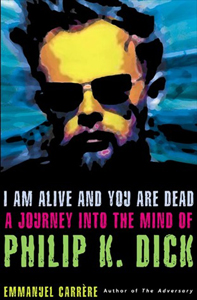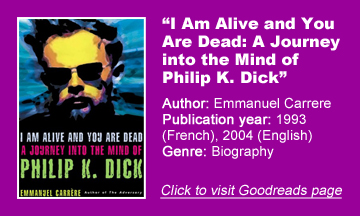French Philip K. Dick mega-fan and novelist Emmanuel Carrere takes one of the most unusual approaches to a biography in “I Am Alive and You Are Dead: A Journey into the Mind of Philip K. Dick” (1993, with the English translation published in 2004).
You’ll want to read Lawrence Sutin’s definitive “Divine Invasions” (1989) first, and then maybe wait a while because Carrere covers a lot of the same ground.
A fresh perspective
But the perspective is different: He uses a third-person omniscient approach to get closer to being in Dick’s head. Therefore we don’t have the comforting distance of a traditional biography; we feel more of PKD’s troubles and pains — and triumphs, but Carrere is less interested in those, just as Dick leaned pessimistic.
The biographer writes in his own engaging style, not attempting to mimic Dick’s, but moments of dark comedy provide a link. Consider this humorous sentence on page 3: (PKD’s mom) “had been assured by a psychiatrist that her child would not suffer from the separation (he complained about it his entire life).”
Carrere has been criticized for not including a bibliography, but it’s clear that he draws from Dick’s letters. I used to think PKD’s obsessive correspondence with friends was a peek into an earlier age when people wrote letters, but Carrere notes that often the recipients of the letters didn’t respond with comparable enthusiasm.
I get the impression that if Dick wasn’t a famous and admired writer (at least in certain circles), he might’ve had a hard time finding people to put up with him for long. Even with that status, Dick’s life is filled with people – especially women – who have had enough of his antics at some point and take off.
Carrere also emphasizes how the sometimes-suicidal PKD found it hard to live with himself and his thoughts. For example, he wrote “The Three Stigmata of Palmer Eldritch” while terrified the whole time of what he was writing.
Novel analyses
While not abandoning his omniscient narrator approach, Carrere peppers in some strong analyses of Dick’s most lauded novels. Dick’s best works leave room for interpretation – sometimes because of subtle writing, sometimes because of unfocused storytelling – and Carrere smooths things out, telling us what these books mean to him and guessing that Dick was fumbling toward these meanings too.
This isn’t an insult toward Dick, who in his later years wondered if he wasn’t using his imagination in his novels but was instead a conduit for VALIS (God) all along.
Because of the books Carrere chooses to emphasize, “I Am Alive” leaves an impression that Dick’s works are all autobiographical. Carrere isn’t trying to be funny, but it comes off that way because he skips over Dick’s work that is less autobiographical. That’s not such a bad thing: By being funny when he’s not necessarily trying to be, the biographer forges another link to his subject.
I’m especially struck by “Confessions of a Crap Artist” coming directly from Dick’s marriage to third wife Anne. It’s slightly disillusioning, because I celebrate Dick’s non-SF catalog as portraits of the stultifying aspects of married life in fast-changing midcentury California, but in truth these novels might be closer to personal diaries.

Therefore, their success as pieces of literature might be accidental — as Dick himself might’ve surmised had he lived long enough to hear praise for these novels. (Tragically, of course, he received little positive feedback about these nine novels during his lifetime, as all except “Crap Artist” were published posthumously.)
A life darkly
The chapter on my favorite Dick novel, “A Scanner Darkly,” is a little disappointing, because Carrere simply repurposes anecdotes from the novel. This is fair enough, because “Scanner” was – except for the SF aspects – an autobiographical account of Dick’s brief period of 1960s drug use on his couch, a way to make sure he was always surrounded by people.
But it’s short on new insight, especially since Carrere doesn’t know the names of the actual people, or – in the case of “Donna” – isn’t given permission to use her real name.
On the other hand, I found it interesting to learn that “Kevin” from “VALIS” is K.W. Jeter, who served as the devil’s advocate in theological arguments with Dick. I like how Carrere uses Dick’s Horselover Fat/Philip K. Dick internal dichotomy to offer an explanation for why “The Divine Invasion” plays so differently from the surrounding books. PKD’s penultimate novel was written by Fat (the spiritually questing part of the author), the biographer surmises.
Carrere has immersed himself in Dick’s letters and speeches in order to reach scholarly conclusions (even though the author tries to avoid a studious air). It’s not a leap into guesswork or assumptions, even if Carrere goes a smidgen closer to that arena than Sutin.
If you’re already well-schooled on PKD, “I Am Alive and You Are Dead” is a fresh angle on familiar material, spiced up by enough of Carrere’s own insights to not be old hat.


